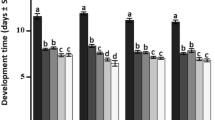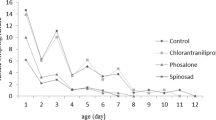Abstract
The influence of temperature and humidity on the biology of insecticide-resistant and susceptible strains of Tribolium castaneum (Herbst) was studied and compared.
At all temperatures (20, 25, 30 and 40°C) and r.h. (30, 50, 70, 90) tested, the insecticide-resistant strain matured earlier than the susceptible strain. For both strains, the lowest and highest temperature limits for embryonic development and egg hatching were 20 and 40°C, respectively. The incubation period for eggs of both strains averaged 14 days at 20°C and 4 days at 30°C.
Females of the insecticide-resistant strain matured for egg laying earlier (24 hr) than the susceptible strain (60 hr) but laid fewer eggs (36 eggs) than the latter strain (238 eggs). At 30°C and 70% r.h. the resistant strain had a shorter developmental period (15 days) than the susceptible strain (21 days).
Temperature influenced the development of larvae of both strains of T. castaneum. Larvae of the susceptible strain did not develop at 20°C and 30% r.h., 20°C and 90% r.h. and 40°C and 30%. r.h., whereas larvae of the resistant strains did.
The pupae of both strains developed at all the temperature and relative humidity regimens tested. Temperature and humidity of stored food would therefore, act together to influence the abundance of strains of T. castaneum and the two factors could be manipulated to suppress the population growth of this beetle on stored food.
Résumé
Nous avons etudie et compare’ l’influence de la temperature et de l’humidete sur la biologie des souches susceptibles et des souches qui resistant a’ l’insecticide. A fortes les temperatures teste’es (20, 25, 30, et 40°C) et a toutes les humidite’s relatives (30, 40, 70, 90), nous avons remarque que la souche que resiste a l’insecticide a muri plus fot que la souche susceptible pour les deux souches, les temperatures les plus basses et les plus hantes pour le developpement embryonnaire ebient de l’ordre de 20 et 40°C respectivement. La periode d’incubation ebit en moyenne de 14 jours a 20°C et de 4 jours a 30°C.
Les femelles de la souche qui resiste a l’insecticide ont alfaint l’age de pondre un seuf plus tot (24 hr) que celles de la souche susceptible (60 hr) mais elles ont pondu moins d’oeufs (36 seufs que les dernieres (238 seufs) a 30°C et 70% r.h. La period de developpement des femelles de la souche qui resiste a l’insecticide (15 jours) etait moins courte que celle des femelles de la souche susceptible (21 jours).
Nous avons renarque l’influence de la temperature sur le developpement des larves des deux souches de T. castaneum. Les larves de la souche susceptibles ne se developpeaient pas a 20°C et 30% r.h., 20°C et 90% r.h. et 40° C et 30% r.h. alorz que les larves des souches resistantes s’y developpeaient.
Les nymphes des deux souches ont temoigne du developpement al toutes les temperatures et humidites relatives testees. Donc, la temperature et l’humidite des vivres enmagasines agissent ensemble pour influer sur l’apondance des souches de T. castaneum, et les deux facteurs penvent etre manipules afin de supprimer la croissance de cet escarbot sur les vivres mis en magasin.
Similar content being viewed by others
References
Adesuyi S.A. (1969) Post-fumigation protection of maize in an aluminium silo with one per cent malathion dust. Rep. Nigerian Stored Prod. Res. Inst. pp. 45–48.
Banks H. J. (1978) Recent advances in the use of modified atmosphere for stored pest control. Proc. 2nd Int. Conf. Stored Prod. Entomol. pp. 198–216.
Champ B. R. and Campbell-Brown M. H. (1970) Insecticide-resistance in Australian Tribolium castaneum (Herbst.) II Malathion resistance in Australia. J. Stored Prod. Res. 6, 111–131.
Dyte C. E. and Forster R. (1976) Incidence of resistance in the United Kingdom. Other beetles. The merchant grain beetle. Pest infest. control 1971–1973, 83–84.
Gray H. E. (1956) Comparison of certain of the biology of the flour beetle—Tribolium castaneum, confusum and destructor. Ph.D. Thesis, University of Minnesota, USA.
Howe R. W. (1965) The effect of temperature and humidity on the oviposition rate of Tribolium castaneum. Bull. entomol. Res. 53, 301–310.
Sawicki R. M. (1969) Resistance of insects to insecticides. Span 22, 50–52.
Solomon M. E. (1956) Control of humidity with potassium hydroxide, sulphuric acid or other solutions. Bull. entomol. Res. 42, 543–554.
Solomon M. E. (1957) Estimation of humidity with cobalt thiocyanate papers and permanent colour standards. Bull. entomol. Res. 48, 489–506.
Williams J. O. and Osuji F. N. C. (1981) Studies on insecticide resistance in Tribolium castaneum (Herbst.). (Coleoptera: Tenebrionidae) in Nigeria. Bull. Grain Technol. XIX, 1, 16–24.
Williams J. O. (1985) A comparative study of the biology of insecticide-resistant and susceptible strains of Tribolium castaneum (Herbst.) (Coleoptera: Tenebrionidae). Ph.D. Thesis, University of Ibadan, Nigeria.
Author information
Authors and Affiliations
Rights and permissions
About this article
Cite this article
Williams, J.O. Influence of Temperature and Humidity on the Biology of Insecticide-Resistant and Susceptible Strains of Tribolium Castaneum (Herbst.) (Coleoptera: Tenebrionidae). Int J Trop Insect Sci 10, 607–615 (1989). https://doi.org/10.1017/S1742758400021731
Received:
Revised:
Published:
Issue Date:
DOI: https://doi.org/10.1017/S1742758400021731




